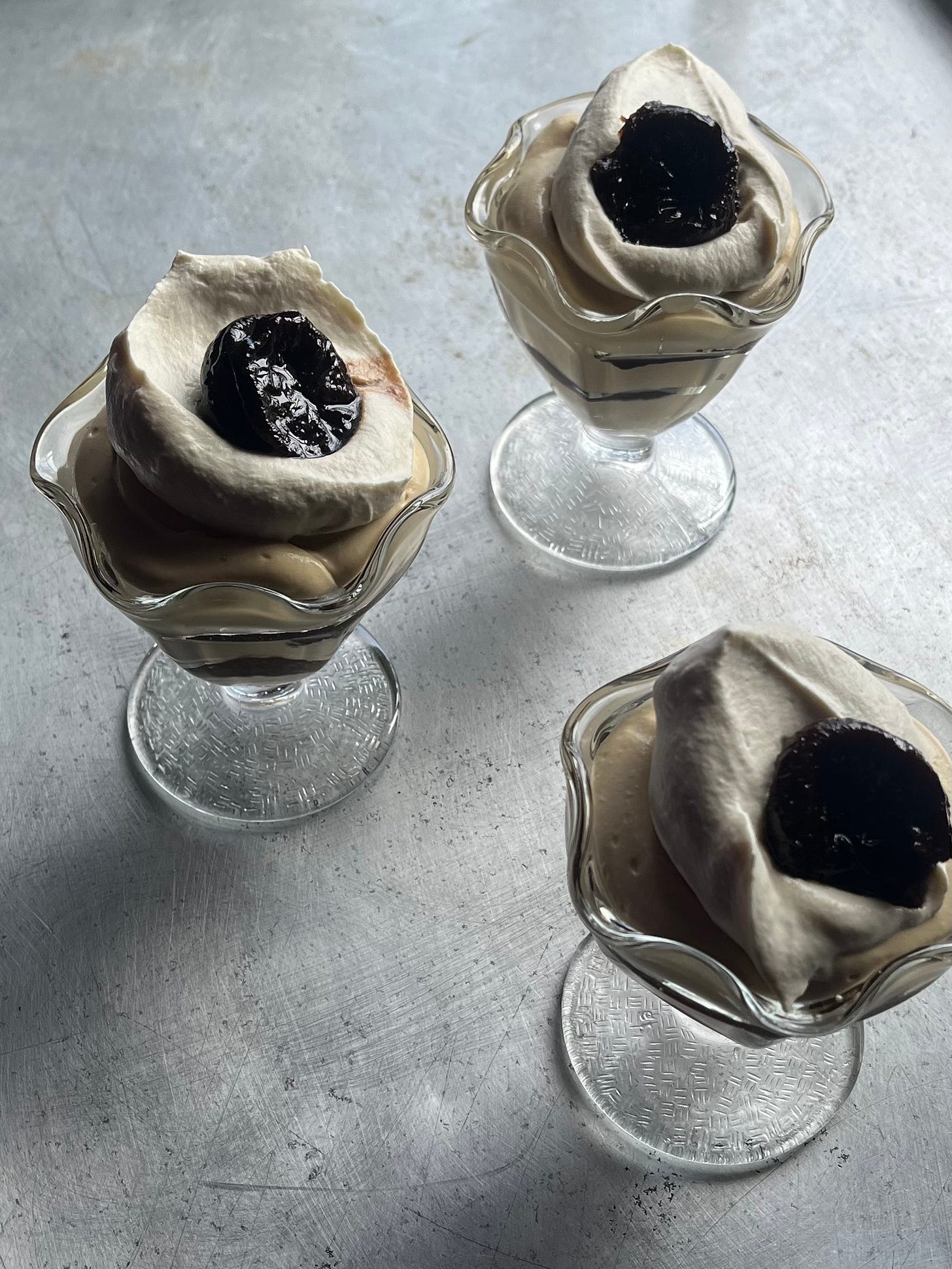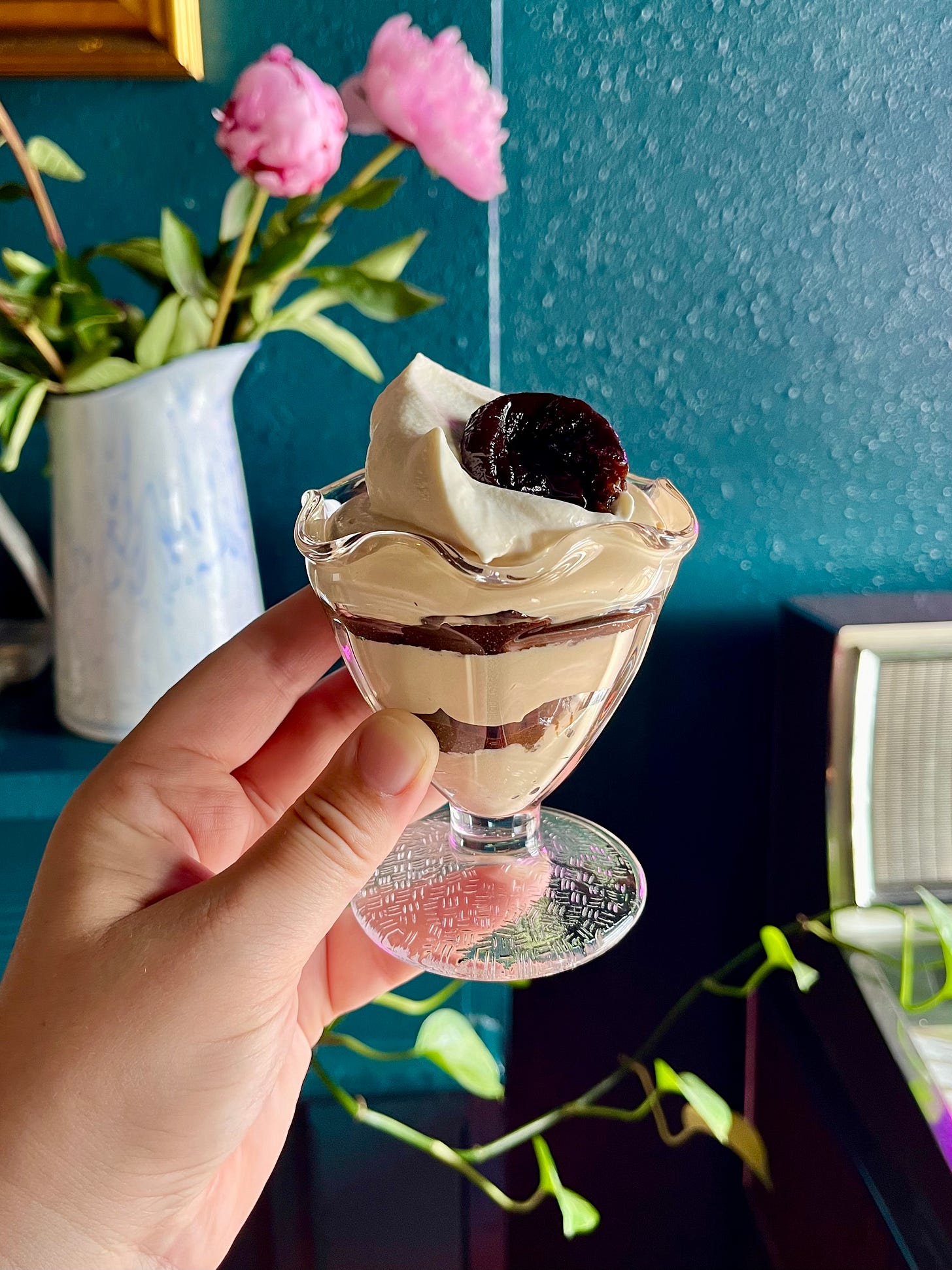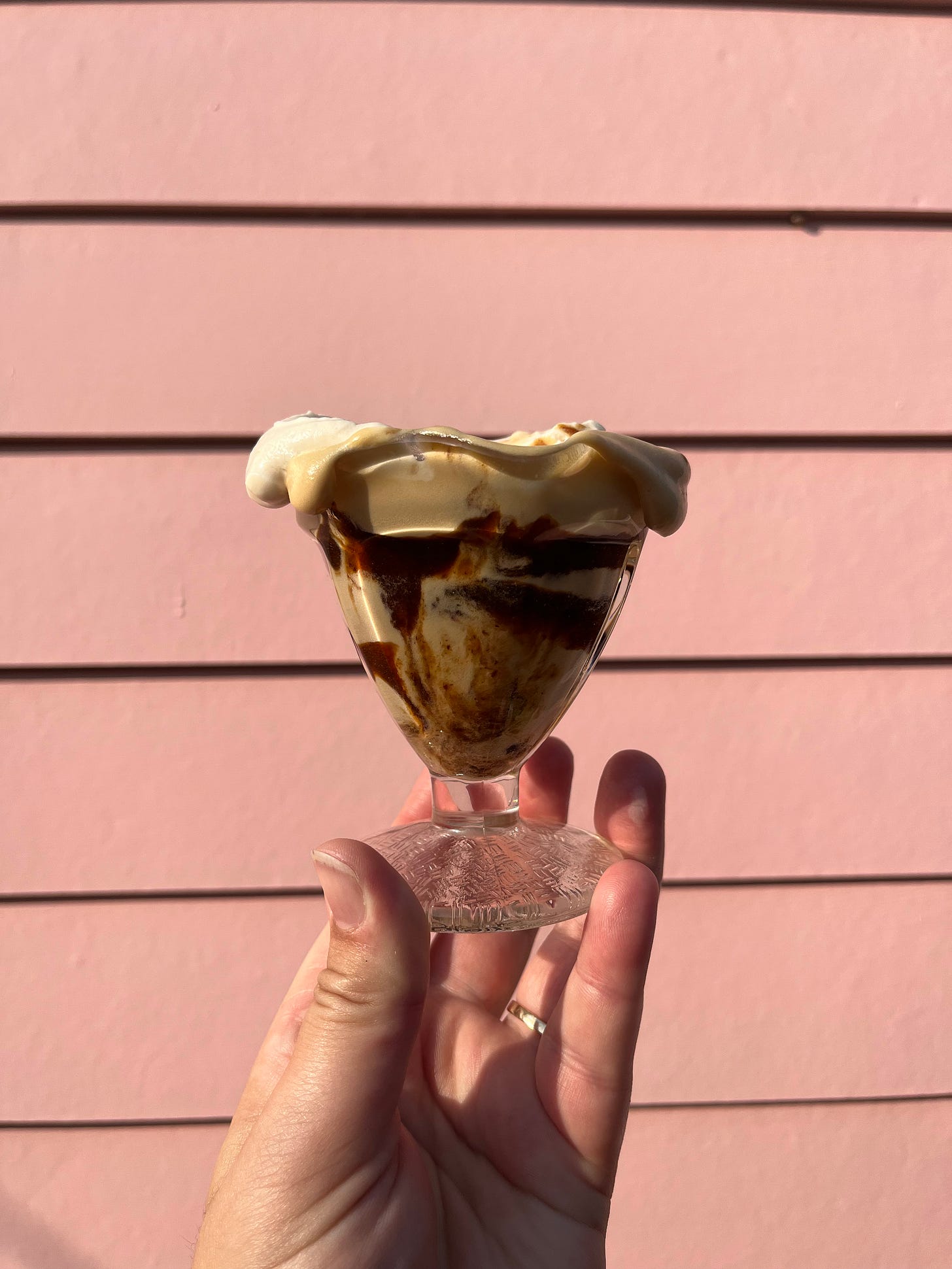A quick announcement!
I’m FINALLY debuting my next pre-recorded baking class this Friday. I’m really excited to share that I’ve been spending months fine-tuning a dome cake class. While it comes with four recipes, the bulk of the class is really about the technique of covering a rounded shape with a silky smooth layer of buttercream for a refined finish, plus three dome cake decorating techniques. It is so, so detailed (thanks in large part to my collaborator Drew, who has meticulously gone over this video and had me add so much context). I’ll have more information on Friday, plus a discount code for the class just for newsletter subscribers!
A recent return to plated desserts
The past few weeks, I’ve been playing a small part in helping open a restaurant. The last time I was hired as a consultant on a plated dessert menu, I was twenty-six years old and had been a pastry chef for less than a year. I had no idea what I was doing. The head chef, the brilliant Brandon Jew, had enjoyed my work at the tiny, beloved Outerlands in San Francisco, and brought me on to develop a menu for the very hyped upcoming restaurant Bar Agricole. The rest of the management team there seemed to have vast reservoirs of money to match their eccentricities. The PR reps bragged about the staff forager and the onsite biodynamic garden producing all of the cocktail garnishes (reader, there’s no way a garden that size could have realistically done that year-round). I wish I could remember the price tag on the custom chandelier that undulated through the dining room, made of hundreds of tubes of blown glass. One owner was maniacally particular about sourcing. I once walked into the kitchen to find him dumping a fifty-pound bag of organic sugar I had ordered into the compost because it wasn’t fair trade. I get this story sounds fake, but 2010 in SF was a wild time. The bubble hadn’t burst and millionaires were giving restaurant keys to alcoholic twenty-somethings with boy problems.
My task was to come up with three intensely seasonal desserts that could be executed by a team of overworked line cooks I barely knew. I’d work my shifts at Outerlands before dashing on the train from the Outer Sunset to SoMa to troubleshoot and taste their mise en place, a wildly untenable situation even with the best of intentions. I was only at Bar Agricole briefly until the all-consuming drama of my personal life sent me back to New Orleans. I actually kind of miss those train rides, firmly believing I was the main character, listening to Bon Iver and gazing out at the fog.
My most recent experience at Acamaya has been entirely different. For one thing, I am now forty and I actually know what I’m doing (mostly). I’m also blessedly free of boy problems. I feel really honored to have helped chef Ana translate her vision of a dessert menu to the plate. It felt like stretching muscles I haven’t used in ages - plated desserts are a whole different ball game than cakes. It’s like a puzzle. First, the dessert needs to be delicious. Then, you’ve got to figure out how to arrange the components on the plate in a visually arresting way. After that, you have to figure out how each component will be made and stored, how much labor that will take, and long it will take for a chef to assemble it when ordered. Can a crispy meringue garnish work in a humid kitchen? Not usually - you end up throwing away so many sticky meringues that the labor it takes to produce them is no longer worth it. Does it make sense to have a cook dash to a freezer ten paces away to add a quenelle of ice cream to a plate? It’s one thing in a home kitchen, but when these steps are repeated over and over during a busy service, you quickly re-arrange a menu to be more physically efficient. Not to mention- a distant freezer is a recipe for ice cream that melts, re-freezes, and gets riddled with ice crystals.
Consulting on a dessert menu is maybe only half about the food - the rest is about implementing systems to make a menu manageable without a full-time pastry chef on staff. I’m lucky that Ana’s back of house team are some of the most kind, focused, and funny chefs I’ve encountered in my career. We’re keeping it short and sweet for now, with a flan and a tres leches cake. I’m really proud of both of them, and of this gorgeous, thoughtful restaurant in general. The biggest con to this gig is remembering that everything in a new kitchen is SHARP - even the edges of hotel pans have not yet been dulled down by years of use and will nick you. I have some new dings to match the half-moon shaped scar on my hand I got when shopping for tart pans for Bar Agricole (nothing like your hand dripping blood in the restaurant supply store when you’re trying to impress a new boss).
I had plated desserts on the brain when I came up with my most recent recipe for California Prunes - a riff on a pudding parfait that I first presented at a collaborative prunes dinner with Ana herself (you can find her own brilliant recipe for a bone-in pork chop with prune mole here). I was briefly famous for a butterscotch pudding I had on the menu of a restaurant uptown- my second full-time pastry chef gig ever. If I could do it all over again, this is the dessert I would come up with instead - all of the nostalgia of butterscotch, but with a sophisticated edge.
The recipe below is sponsored by California Prunes! Click here for a printer-friendly version.
Chicory + Prune Butter Parfait
Prunes and coffee are a classic match, and this classy layered dessert pairs these flavors with a Louisiana twist. Chicory powder, available online or at natural food stores, is a dissolvable instant coffee substitute, famous as the star of the New Orleans-style cafe au lait. I love it for its earthy, powerful flavor that stands up beautifully to milk and cream, and is naturally caffeine-free. Here I infuse the chicory powder into a diplomat cream, which sounds fancy but is basically pudding lightened with whipped cream. The diplomat cream has a lighter, airier mouthfeel than straight pastry cream, with just a touch of gelatin to stabilize it. You may remember I used a similar filling in my walnut chiffon cake recipe- this version is new + improved (and easier to make!).
Layered in a glass with a bright prune butter and brown sugar whipped cream, this parfait is a glam chilled dessert that altogether tastes, somehow, just like butterscotch pudding. You could enjoy it as is, or top with crumbled chocolate wafer cookies for a bit of crunch. Or imagine it spooned into a chocolate cookie pie crust?
Recipe notes:
This recipe makes about six parfaits, depending on the size of the individual serving dishes you’re using, or you can make one big one like a trifle and spoon it out family-style.
This recipe was developed with instant chicory powder in mind - I use Anthony’s brand. Sometimes chicory is sold in granules instead. In that case, you can use roughly the same amount, but you may notice the granules don’t entirely dissolve - that’s no issue, as we’ll be straining our pudding anyway. In a pinch, you can easily substitute two teaspoons of instant espresso powder for the chicory powder.
You may also leave the gelatin out - your diplomat will have a softer set, and you may want to assemble the parfaits immediately upon folding the whipped cream into the chicory pastry cream. If made as written, you can make the chicory diplomat up to two days ahead, and the prune butter up to three or four days ahead.
The vincotto in the prune butter is entirely optional, but delicious if you happen to have it laying around! Vincotto is a thick, bright syrup made from reduced grape must - I love adding a little to jam recipes to deepen the fruity flavor. It’s especially lovely in roasted strawberries or with simmered prunes, as I do here. You could also substitute bourbon or rum for a more adult dessert (rum would really bring out the butterscotch notes).
Chicory Diplomat Cream
1 cup / 240 grams milk
2 egg yolks
½ cup / 100 grams sugar
1 tablespoon cornstarch
Hefty pinch salt
1 tablespoon chicory powder (or two teaspoons espresso powder, see note)
½ teaspoon powdered gelatin (optional, see note)
2 oz / 4 tablespoons/ 56 grams butter, chilled and cubed
¾ cup + 2 tablespoons / 198 grams cream
Prepare a shallow bowl with a strainer set over it and set aside.
Combine the egg yolks and the milk in a liquid measuring cup and set aside. Combine the sugar, cornstarch, salt, chicory powder, and gelatin in the bottom of a medium non-reactive pot and whisk thoroughly to combine. Slowly pour in the milk/yolk mixture, whisking all the while so there are no visible lumps of cornstarch.
A quick aside - typically with powdered gelatin, you’d bloom it in water separately and add it in later. I tweak this method by allowing it to bloom with the milk in the initial step - by suspending the gelatin with the sugar and cornstarch, you shouldn’t see any lumps. Another reason one might bloom gelatin separately is that it loses its strength when boiled for a considerable length of time, but this pastry cream will only be at a rolling simmer for about a minute. I originally developed this method because I hate fussing about with blooming powdered gelatin and I’m a bit lazy about it. I’ve never noticed any ill effects when doing it this way and so I’ve never looked back. If you’re not using gelatin just ignore all this and proceed with the next step.
Place the pot over low-to-medium heat and cook, whisking all the while, until the chicory pudding has thickened, and you begin to see fat, rolling bubbles simmering across the surface. Continue to cook and whisk vigorously for an additional one minute. Remove from the heat and taste your pudding - you shouldn’t be able to taste the powdery finish of cornstarch - if you do, you may need to cook for an additional 20 seconds or so. Take care not to overcook at this stage - we cook the pastry cream for a minute because any longer can weaken the bonds of cornstarch that we've developed, and result in a looser (or curdled) pudding.
Whisk in the butter until totally incorporated, and strain the pudding into the prepared dish. Press plastic wrap directly to the surface of the pudding and refrigerate until totally chilled.
When the pudding has cooled completely, put the heavy cream into a stand mixer fitted with a whisk attachment and whip until it achieves loose peaks. Add the chilled pastry cream to the mixer and whisk at high speed until it’s fully incorporated into the whipped cream, about 15 to 20 seconds or so. The result will be a beautiful coffee-colored, voluptuous cream with a velvety finish. Chill until ready to assemble your parfaits.
Prune Butter
1 packed cup / 260 grams prunes
1 cup / 227 water
¼ cup / 54 grams brown sugar
Pinch salt
2 teaspoons vincotto (optional, see note)
Place all of the ingredients in a small non-reactive pot and simmer over medium heat until the prunes are very soft and the liquid has reduced and taken on a slightly syrupy consistency, about three to four minutes. You should be able to easily halve the prunes with a wooden spoon, but you don’t want to simmer away all of the liquid. Before blending your butter, you can pluck out six syrupy prunes from the liquid and set them aside for garnish, if you like. Tip the remaining prune mixture into a blender and blend until very smooth (I use a magic bullet). Set aside to cool to room temperature.
Brown Sugar Whipped Cream
1 cup / 227 grams cream
¼ cup / 54 grams brown sugar
Pinch salt
1 teaspoon vanilla extract
Hold off on whipping the brown sugar cream until you’re ready to build your parfait. Assemble all of the ingredients in the bowl of a stand mixer fitted with a whisk attachment (or use a handheld mixer). Whip the cream on medium speed until it has thickened and achieved soft peaks.
To assemble the parfaits:
Spoon or pipe the chicory diplomat cream and the prune butter into sundae glasses or mason jars, alternating the two to create a striated effect. This recipe will make about six servings, depending on the size glass you’re using. Top with the brown sugar whipped cream. The parfaits can be assembled up to a day ahead sans the brown sugar whip, or up to two hours ahead once garnished with the cream. If you’re folding in chocolate wafer crumbs, sprinkle them in between the layers or on top. Garnish with the reserved syrupy prunes, if you like!









Its so good to see prunes having a moment in the spotlight. I don't know about elsewhere, but here in Australia, they are seriously underrated other than in aged care homes! Its a shame because they are a fabulous ingredient. I'm off to track down some chicory.
Very excited to try this – there's an abundance of instant chicory at the Russian and Uzbek markets near me so I almost always have a bag lurking in the pantry, hoping for its big break